Embark on an extraordinary journey beneath the waves as we unveil the world’s most captivating scuba diving locations. From vibrant coral reefs teeming with life to awe-inspiring underwater wrecks, each destination offers a unique and unforgettable experience. Dive into the depths of our comprehensive guide and discover the wonders that await you in the ocean’s embrace.
Whether you’re a seasoned diver or a curious beginner, our curated list of dive sites will inspire your next underwater adventure. Dive into the pristine waters of the Great Barrier Reef, explore the enigmatic depths of the cenotes in Mexico, or encounter the gentle giants of the Galapagos Islands. Each location promises an immersive experience that will leave you breathless.
Diving Destinations
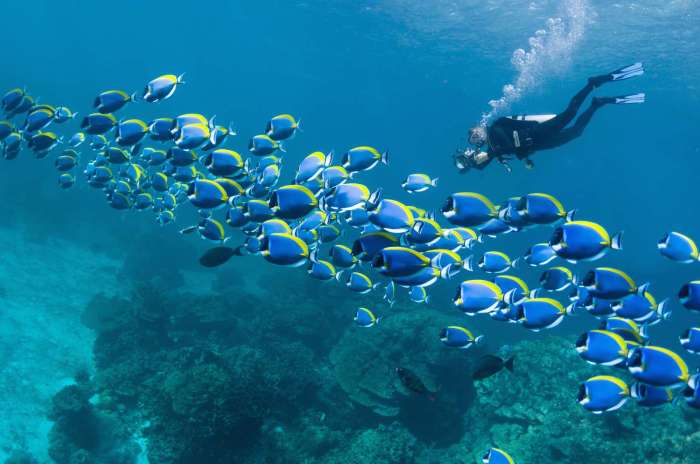
The world’s oceans offer a vast array of scuba diving destinations, each with its own unique attractions. From vibrant coral reefs to ancient shipwrecks, there’s something for every diver.
To help you plan your next underwater adventure, here’s a comprehensive list of popular scuba diving locations worldwide, organized by region:
Asia-Pacific
- Great Barrier Reef, Australia: The world’s largest coral reef system, home to over 1,500 species of fish and 400 species of coral.
- Komodo National Park, Indonesia: Known for its Komodo dragons, as well as its pristine coral reefs and diverse marine life.
- Raja Ampat, Indonesia: A remote archipelago with some of the richest marine biodiversity on the planet.
- Sipadan Island, Malaysia: A small island with incredible underwater visibility and a wide variety of marine life, including sharks, rays, and turtles.
- Palau: A Pacific island nation with crystal-clear waters and over 1,300 species of fish.
Europe
- Mediterranean Sea: Home to a wide variety of marine life, including dolphins, whales, and sea turtles.
- Red Sea: Known for its pristine coral reefs and abundant fish life.
- Scandinavian Fjords: A unique diving experience with cold, clear waters and diverse marine life, including seals, whales, and dolphins.
North America
- Florida Keys, USA: A chain of islands with a vibrant coral reef system and abundant marine life.
- Monterey Bay, USA: A marine sanctuary with a diverse array of marine life, including sea otters, whales, and dolphins.
- Galapagos Islands, Ecuador: A unique archipelago with a wide variety of marine life, including sharks, rays, and sea lions.
Central and South America
- Cozumel, Mexico: A world-renowned diving destination with pristine coral reefs and abundant marine life.
- Belize Barrier Reef, Belize: The largest barrier reef in the Western Hemisphere, with over 1,000 species of fish and 500 species of coral.
- Roatan, Honduras: A small island with beautiful coral reefs and a wide variety of marine life.
Africa
- Red Sea, Egypt: Home to some of the world’s most famous dive sites, including the SS Thistlegorm shipwreck.
- Sodwana Bay, South Africa: A marine protected area with a diverse array of marine life, including sharks, rays, and turtles.
- Pemba Island, Tanzania: A remote island with pristine coral reefs and a variety of marine life.
Marine Ecosystems
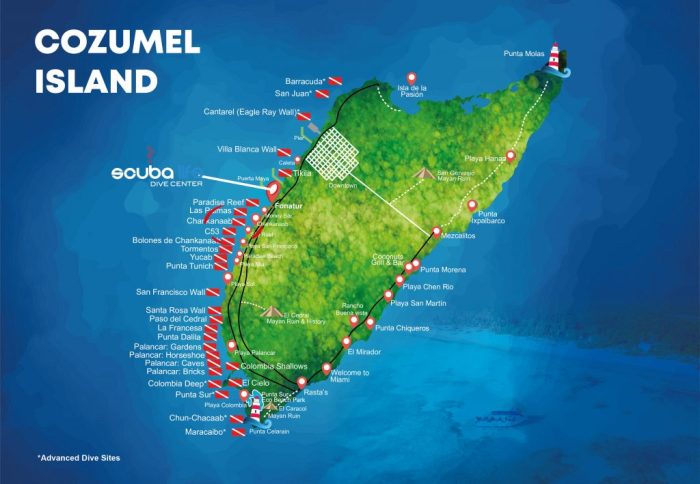
Scuba diving offers a glimpse into the diverse marine ecosystems that thrive beneath the ocean’s surface. These ecosystems, ranging from coral reefs to kelp forests, are teeming with an astonishing variety of life, playing a vital role in maintaining the health and balance of our planet.
The intricate web of interactions between marine species and their habitats creates a dynamic and resilient environment. These ecosystems provide essential services such as food, shelter, and breeding grounds for countless marine organisms. They also act as carbon sinks, absorbing carbon dioxide from the atmosphere and mitigating climate change.
Coral Reefs
Coral reefs are among the most iconic and biologically diverse marine ecosystems. These vibrant underwater cities are formed by colonies of tiny coral animals that secrete a hard exoskeleton. Coral reefs support a vast array of marine life, including fish, invertebrates, and algae.
- Hard Corals: These corals build massive structures that provide shelter and habitat for a myriad of marine species.
- Soft Corals: These corals lack a hard exoskeleton and exhibit a wide range of shapes and colors, adding to the reef’s biodiversity.
- Fish Species: Coral reefs are home to over 4,000 species of fish, each adapted to a specific niche within the reef ecosystem.
- Invertebrates: Coral reefs teem with invertebrates such as crabs, lobsters, shrimp, and mollusks, which contribute to the reef’s ecological balance.
Kelp Forests
Kelp forests are underwater forests dominated by giant kelp, a type of brown algae. These forests create a unique habitat for a diverse array of marine organisms, including fish, invertebrates, and marine mammals.
- Giant Kelp: These towering algae form dense underwater canopies that provide shelter and food for marine life.
- Fish Species: Kelp forests support a wide variety of fish species, including rockfish, lingcod, and salmon.
- Invertebrates: Kelp forests are home to a multitude of invertebrates, such as sea urchins, sea stars, and crabs.
- Marine Mammals: Kelp forests provide feeding and breeding grounds for marine mammals such as sea otters and harbor seals.
Seagrass Beds
Seagrass beds are underwater meadows formed by flowering plants that have adapted to live in saltwater. These ecosystems provide essential habitat and food for a variety of marine species.
- Seagrass Species: Seagrass beds are composed of different species of seagrass, each with its own unique ecological role.
- Fish Species: Seagrass beds provide shelter and feeding grounds for a variety of fish species, including juvenile fish and seahorses.
- Invertebrates: Seagrass beds support a diverse community of invertebrates, such as crabs, shrimp, and snails.
- Nutrient Cycling: Seagrass beds play a crucial role in nutrient cycling, helping to maintain the health and productivity of the marine ecosystem.
Dive Sites
Dive sites offer a diverse range of underwater experiences, each with its own unique characteristics. Understanding the different types of dive sites can help divers choose the best locations that align with their experience and interests.
The depth, visibility, and level of difficulty vary depending on the type of dive site. Reefs, wrecks, and caves are among the most popular dive sites, each offering distinct challenges and rewards.
Reefs
Coral reefs are vibrant underwater ecosystems teeming with diverse marine life. Reefs offer relatively shallow depths, making them suitable for beginners and experienced divers alike. The visibility can vary depending on the location, but reefs typically offer good visibility, allowing divers to admire the colorful corals and marine creatures.
Scuba diving is an exciting and rewarding activity that allows you to explore the underwater world. There are many great scuba diving locations around the world, from the Great Barrier Reef to the Galapagos Islands. If you’re looking for a great place to go scuba diving, be sure to check out the scuba diving locations section of our website.
Wrecks
Exploring sunken ships or aircraft is a unique and often awe-inspiring experience. Wrecks can range from small fishing boats to large warships, and they offer a glimpse into maritime history. Wreck dives can be more challenging than reef dives due to the potential for limited visibility and navigation hazards. However, the opportunity to explore these underwater time capsules makes it a popular choice for experienced divers.
Caves
Cave diving requires specialized training and equipment, as it involves exploring underwater caves and caverns. Cave dives offer a unique and challenging experience, but they can also be dangerous. Divers must be aware of the potential risks, such as limited visibility, tight passages, and the need for specialized equipment.
Tips for Choosing a Dive Site
- Consider your experience level and comfort with different depths and visibility conditions.
- Research the dive sites in advance to learn about the marine life, topography, and any potential hazards.
- Choose a dive site that aligns with your interests, whether it’s exploring colorful reefs, discovering sunken wrecks, or venturing into underwater caves.
- Consult with local dive operators or instructors for recommendations and guidance based on your experience and preferences.
Diving Techniques

Scuba diving requires a range of specialized techniques to ensure safety and enjoyment. These techniques include proper breathing control, buoyancy management, and underwater navigation.
Scuba diving involves breathing compressed air underwater, which requires divers to learn specific breathing techniques to avoid decompression sickness and other health risks. Proper breathing involves inhaling and exhaling slowly and continuously, avoiding holding your breath or breathing too quickly.
Buoyancy Control
Buoyancy control is crucial in scuba diving. Divers use a buoyancy compensator device (BCD) to adjust their buoyancy, allowing them to ascend, descend, or maintain a neutral position underwater. Mastering buoyancy control enables divers to move effortlessly and explore underwater environments without expending excessive energy.
Underwater Navigation
Underwater navigation is essential for divers to explore and return to their starting point safely. Divers use various techniques, such as following a compass, using natural landmarks, and maintaining visual contact with the dive boat. Underwater navigation requires divers to be aware of their surroundings, plan their dives, and communicate effectively with their dive buddies.
To delve into the captivating realm of scuba diving, it’s essential to discover the world’s most enchanting diving destinations. Whether you’re an experienced diver or just starting your underwater journey, explore scuba diving locations that will leave you mesmerized. From vibrant coral reefs to enigmatic shipwrecks, these destinations offer unforgettable encounters with marine life and breathtaking underwater landscapes.
Diving Styles, Scuba diving locations
There are various diving styles that cater to different preferences and environments. Some common diving styles include:
- Drift diving: This involves diving with the current, allowing divers to cover large distances and explore underwater areas that would otherwise be difficult to reach.
- Night diving: Night diving offers a unique opportunity to observe nocturnal marine life and experience a different underwater environment.
Marine Life
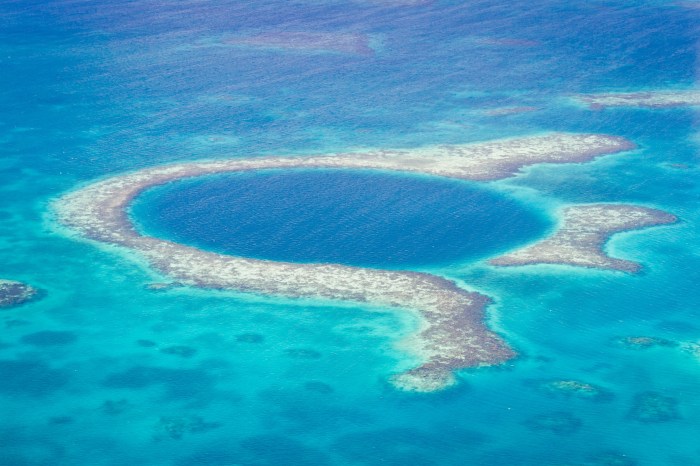
Scuba diving offers divers the opportunity to observe a diverse array of marine life in their natural habitat. From vibrant coral reefs to underwater caves and wrecks, each scuba diving location boasts its own unique collection of marine species.
Understanding the behavior, habitat, and conservation status of these species is essential for responsible diving practices. By following proper guidelines and respecting the underwater environment, divers can help protect and preserve these delicate ecosystems.
Common Marine Species
- Coral Reef Fish: Parrotfish, clownfish, angelfish, butterflyfish, and surgeonfish are just a few of the colorful and diverse species that inhabit coral reefs. These fish rely on the reef for food, shelter, and reproduction.
- Sharks: Sharks are apex predators that play a vital role in maintaining the balance of marine ecosystems. Divers may encounter various shark species, including nurse sharks, reef sharks, and hammerhead sharks.
- Rays: Rays are graceful creatures that glide through the water. Divers may encounter stingrays, eagle rays, and manta rays, which range in size from small to large.
- Marine Mammals: Dolphins, seals, and sea lions are often encountered by divers. These intelligent and playful animals are a joy to observe in their natural environment.
- Sea Turtles: Sea turtles are ancient creatures that have survived for millions of years. Divers may encounter green sea turtles, loggerhead sea turtles, and hawksbill sea turtles, which are listed as endangered or threatened species.
Responsible Marine Life Observation
- Maintain a Safe Distance: Always maintain a respectful distance from marine life to avoid disturbing or stressing them.
- Avoid Touching: Touching marine life can damage their delicate skin or disrupt their behavior. Observe them from a distance instead.
- Use Underwater Photography Responsibly: Use flash photography sparingly and avoid using it directly in the eyes of marine animals.
- Respect Nesting and Breeding Sites: Avoid disturbing nesting or breeding areas to protect vulnerable species.
- Report Unusual Behavior: If you observe any unusual behavior or signs of distress in marine life, report it to the dive operator or local authorities.
Diving Equipment
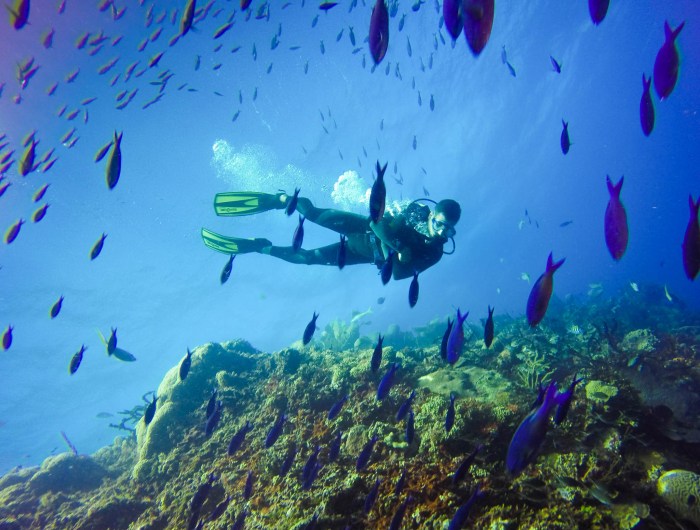
Embarking on a scuba diving adventure requires proper equipment to ensure safety and comfort underwater. Essential gear includes wetsuits, regulators, and dive computers, each playing a crucial role in a diver’s experience.
Wetsuits
- Purpose: Protect divers from cold water temperatures and potential abrasions.
- Proper Use: Choose a wetsuit with the appropriate thickness for the water temperature and ensure a snug fit to minimize water entry.
Regulators
- Purpose: Reduce high-pressure air from the scuba tank to a breathable level.
- Proper Use: Maintain the regulator by rinsing it with fresh water after every dive and servicing it regularly by a qualified technician.
Dive Computers
- Purpose: Monitor depth, dive time, and other essential dive parameters.
- Proper Use: Familiarize yourself with the computer’s functions and settings before diving and always double-check depth and time readings.
Dive Training and Certification
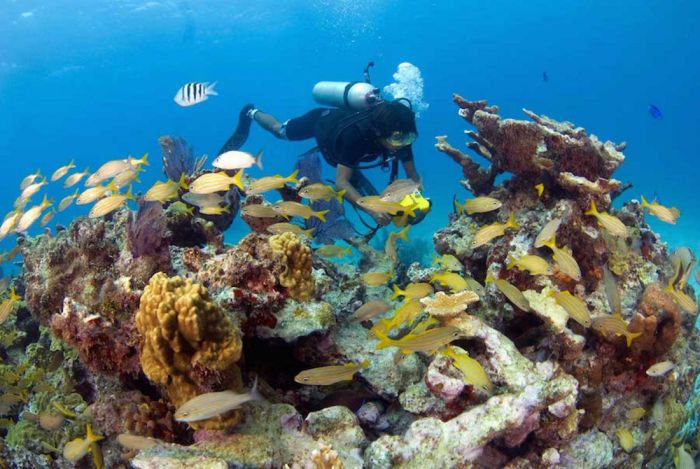
Scuba diving is an exhilarating activity that requires proper training and certification to ensure safety and enjoyment. Various levels of certification are available, catering to divers of different skill levels and experience.
Obtaining a diving certification is highly recommended for several reasons. It provides a structured and standardized framework for learning diving techniques, safety protocols, and emergency procedures. Certification also demonstrates your competence to dive independently and enhances your credibility with dive operators and fellow divers.
Choosing the Right Training Program
Selecting the right training program is crucial for a positive learning experience. Consider the following factors:
- Reputation and experience: Opt for a reputable training agency with a proven track record of providing high-quality instruction.
- Instructor qualifications: Ensure the instructor is certified and experienced in the specific level of certification you are seeking.
- Course curriculum: Review the course syllabus to ensure it aligns with your learning goals and includes both theoretical and practical components.
- Class size: Smaller class sizes typically allow for more personalized instruction and interaction with the instructor.
- Location and schedule: Choose a program that offers convenient locations and schedules that fit your availability.
Continuing Education and Specialty Courses
Once certified, continuing education and specialty courses provide opportunities for experienced divers to enhance their skills and knowledge. These courses cover various aspects of diving, such as:
- Advanced diving techniques (e.g., deep diving, wreck diving)
- Specialized equipment (e.g., sidemount diving, rebreather diving)
- Marine ecology and conservation
- Dive leadership and supervision
By pursuing continuing education and specialty courses, divers can expand their diving capabilities, enhance their safety, and explore new underwater environments.
Safety Considerations
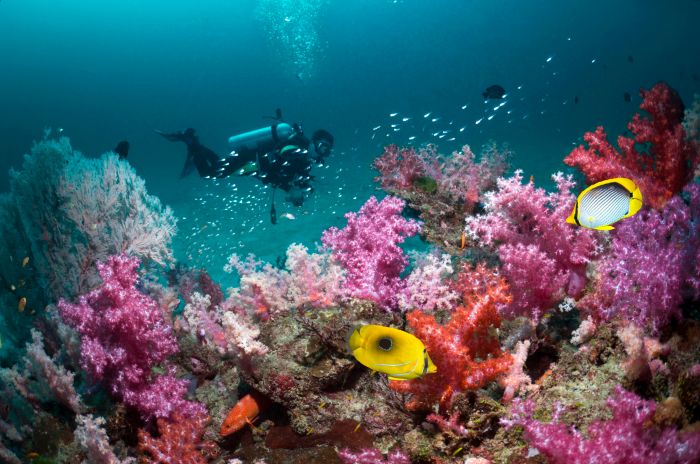
Scuba diving is an inherently risky activity, and it is crucial to prioritize safety to minimize potential hazards and ensure a positive diving experience. Understanding common risks and implementing appropriate safety measures are essential for divers of all levels.
Divers must be aware of potential hazards such as decompression sickness, nitrogen narcosis, and oxygen toxicity. Decompression sickness occurs when nitrogen bubbles form in the body’s tissues due to rapid ascent, leading to joint pain, fatigue, and neurological symptoms. Nitrogen narcosis can impair judgment and coordination at depths greater than 30 meters, while oxygen toxicity can cause seizures or unconsciousness if divers breathe pure oxygen at depths below 6 meters.
When it comes to scuba diving locations, there are countless options to choose from around the world. Whether you’re a beginner or an experienced diver, there’s a location that’s perfect for you. From the crystal-clear waters of the Caribbean to the vibrant coral reefs of the Pacific, there are scuba diving locations that cater to every taste and skill level.
For more information on scuba diving locations, visit scuba diving locations.
Dive Planning
Proper dive planning is crucial for a safe diving experience. Divers should consider factors such as the dive site, weather conditions, and their own experience and fitness levels. It is essential to research the dive site, including its depth, visibility, and any potential hazards. Divers should also check weather forecasts and be prepared to adjust their plans if necessary.
Buddy Systems
Diving with a buddy is a fundamental safety measure. Buddies should stay within sight of each other throughout the dive and communicate regularly. Divers should be familiar with each other’s skills and experience levels and be prepared to assist each other in case of an emergency.
Emergency Procedures
Divers should be trained in emergency procedures and carry appropriate safety equipment. In the event of an emergency, divers should remain calm and follow established protocols. This may involve surfacing slowly, using a buoyancy compensator device (BCD) to control ascent, and seeking assistance from other divers or the surface crew.
Environmental Impact
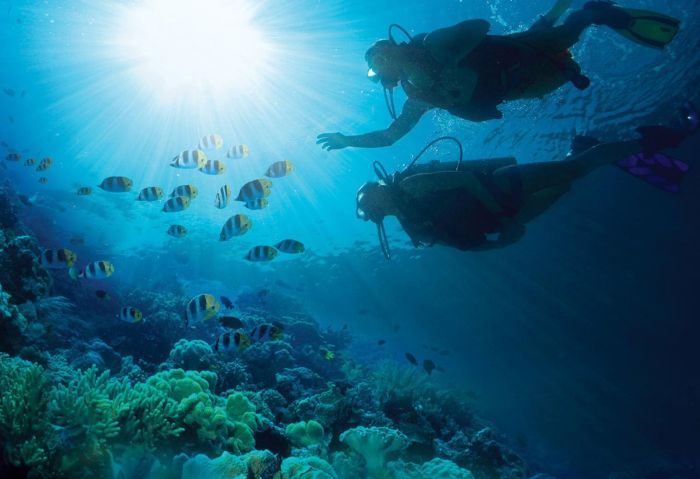
Scuba diving has the potential to have a significant impact on the marine environment, both positive and negative. It’s important for divers to be aware of these potential impacts and to take steps to minimize their footprint.
One of the most important things divers can do is to avoid touching marine life. This can damage delicate organisms and disrupt their natural behavior. Divers should also be careful not to stir up sediment, which can smother corals and other marine life.
Responsible Diving Practices
In addition to avoiding touching marine life and stirring up sediment, divers can also help to minimize their impact by:
- Using environmentally friendly sunscreen
- Avoiding the use of single-use plastics
- Properly disposing of waste
- Respecting dive site regulations
By following these simple tips, divers can help to protect the marine environment and ensure that future generations can enjoy the underwater world.
Contribution to Marine Conservation Efforts
In addition to minimizing their impact, divers can also contribute to marine conservation efforts by:
- Supporting organizations that work to protect the marine environment
- Participating in citizen science projects
- Educating others about the importance of marine conservation
By taking these steps, divers can help to make a difference and ensure that the marine environment is healthy for generations to come.
Travel Planning
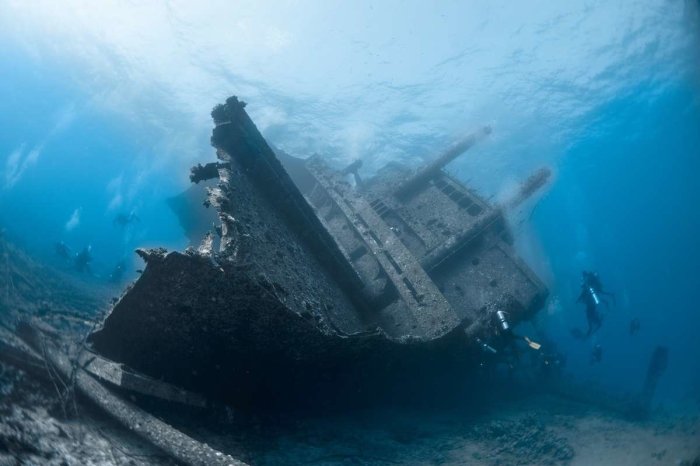
Planning a scuba diving trip requires careful consideration of various aspects to ensure a safe and enjoyable experience. This includes choosing the right destination, booking accommodations, and arranging transportation. Additionally, travel insurance and other safety measures should be taken into account for a worry-free adventure.
Choosing a Destination
Selecting a scuba diving destination depends on factors such as experience level, interests, and budget. Research different locations to find one that aligns with your diving preferences. Consider the marine life, visibility, water temperature, and availability of dive sites that suit your skill level.
Booking Accommodations
Book accommodations in advance, especially during peak season, to avoid last-minute surprises. Choose a hotel or resort that caters to divers, offering amenities such as dive storage, equipment rental, and dive boat access. Consider the location’s proximity to dive sites and other attractions.
Arranging Transportation
Plan your transportation to and from the dive destination, including flights, airport transfers, and local transportation. Consider renting a car if flexibility and convenience are important. Alternatively, arrange for airport transfers and book local taxis or buses to reach your accommodations and dive sites.
Travel Insurance
Protect yourself against unexpected events by purchasing travel insurance. Ensure it covers medical emergencies, trip cancellations, lost luggage, and diving-related incidents. Read the policy carefully to understand the coverage and exclusions.
Finding and Booking Dive Tours
Research and book dive tours in advance to secure a spot, especially if visiting popular destinations. Consider the operator’s reputation, experience, and safety record. Read reviews and ask for recommendations from other divers. Inquire about group sizes, dive sites visited, and equipment rental options.
Liveaboard Options
For an immersive diving experience, consider a liveaboard trip. These vessels provide accommodation and diving facilities, allowing you to explore multiple dive sites over several days. Choose a liveaboard that fits your budget and preferences, considering factors such as boat size, amenities, and itinerary.
Last Point: Scuba Diving Locations
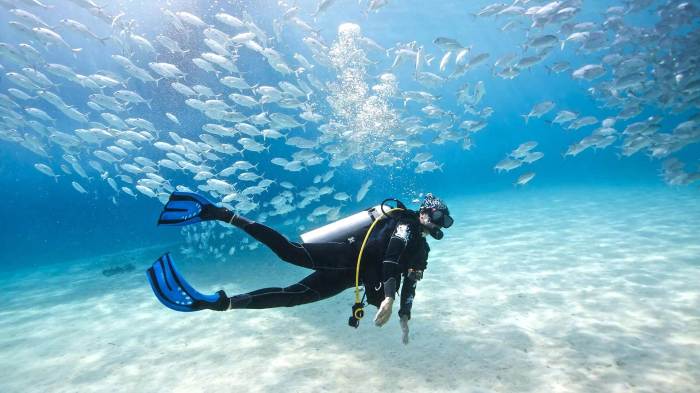
As you venture through the world’s scuba diving havens, remember to embrace the responsibility that comes with exploring these fragile ecosystems. Dive respectfully, minimize your impact on the environment, and contribute to marine conservation efforts. Let us all play a part in preserving the beauty of these underwater wonders for generations to come.
Commonly Asked Questions
What are the most popular scuba diving destinations?
Some of the most popular scuba diving destinations include the Great Barrier Reef in Australia, the Red Sea in Egypt, the Maldives, the Galapagos Islands, and the Caribbean Sea.
What are the different types of dive sites?
There are various types of dive sites, including coral reefs, wrecks, caves, walls, and drop-offs. Each type of dive site offers a unique experience and challenges.
What is the best way to choose a dive site?
When choosing a dive site, consider your experience level, interests, and the time of year you will be diving. It’s also important to research the dive site in advance to learn about the depth, visibility, and currents.